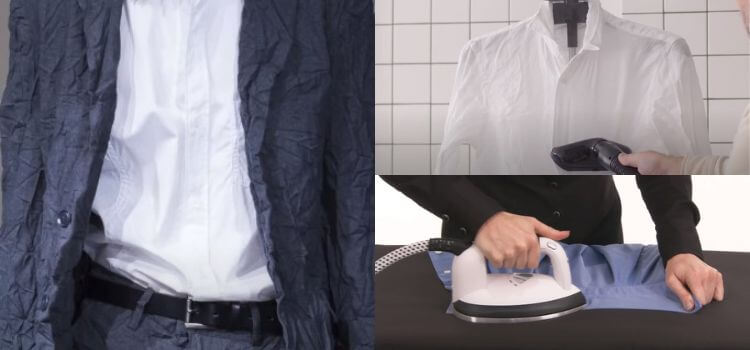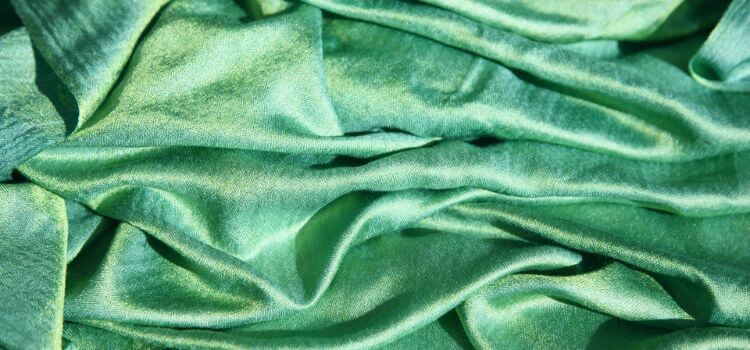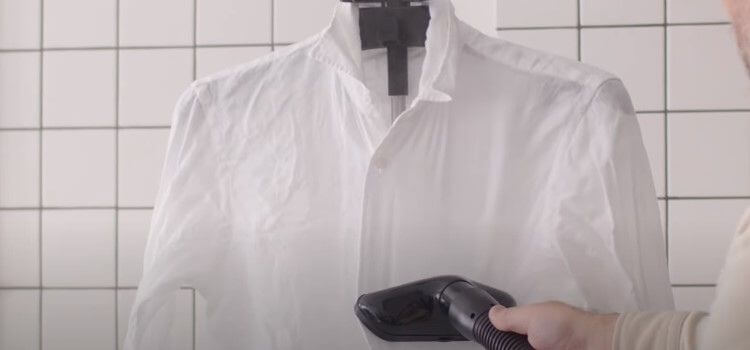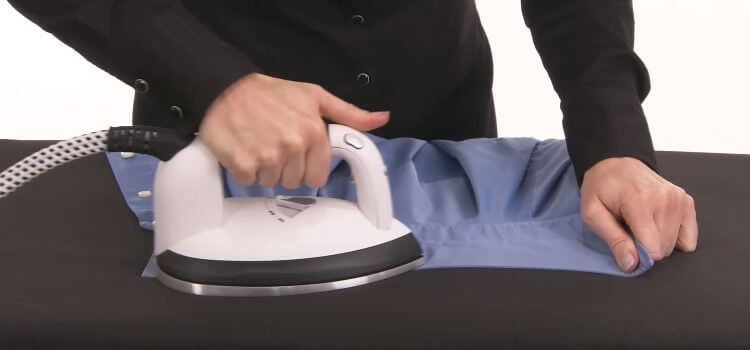If you buy via any of our links, there will be no additional cost to you, and we will receive a tiny commission. More information is available on our Affiliate Disclosure page.

How to Get Wrinkles Out of Rayon?
How to get wrinkles out of rayon? Uncover effortless tips to banish wrinkles from rayon garments and achieve a smooth, pristine look. Unveil the secrets to wrinkle-free rayon perfection now.
Just imagine slipping into your beloved rayon dress or blouse only to find it plagued with unattractive creases. Those obstinate wrinkles have a sneaky way of infiltrating your clothing.
But don’t worry! Wrinkles are a common enemy of rayon fabric, but with a bit of know-how, you can turn this struggle into a pleasurable, wrinkle-free trip.
Knowing how to vanquish creases in rayon clothes is like holding a magic wand. It’s not just about looking good; it’s also about keeping your clothes looking good and lasting a long time.
Consider your rayon clothing to be works of art that require the highest attention. In this book, we’ll reveal the secrets of living in a wrinkle-free rayon world, where you’ll discover how to smooth out those wrinkles with grace and delicacy.
So, let us go on this adventure to find the secret of wrinkle removal for rayon and make it a pleasurable and fulfilling experience.

What is Rayon, and What Makes it Prone to Wrinkles?
Rayon: An Extraordinary Fabric
Rayon, often known as “artificial silk” or “viscose,” is an intriguing fabric that combines the best of both the natural and synthetic worlds. This adaptable fabric is made of cellulose fibers, which are commonly obtained from wood pulp or bamboo.
What distinguishes rayon is its ability to resemble the drape, softness, and shine of natural fabrics such as silk and cotton while being less expensive and easier to create.
Rayon Is Wrinkle-Prone: Rayon Is Wrinkle-Prone
Let us now solve the enigma of why rayon has a reputation for being a little wrinkle-prone:
Nature of the Hygroscopic:
Rayon absorbs moisture from its surroundings because it is hygroscopic. While this feature helps to rayon’s comfort by wicking moisture away from your skin, it also implies that rayon fibers can expand and become more prone to wrinkles when exposed to humidity or wetness.
Inadequate Natural Resilience:
Unlike other natural fabrics, such as wool or cotton, rayon does not have intrinsic durability or “memory.” This implies that when folded or crumpled, it does not naturally return to its previous shape. Instead, it just keeps the creases and wrinkles if adequately managed.
Sensitivity to Heat:
Rayon is heat-sensitive. High temperatures can cause its fibers to weaken, making it more prone to creasing. Excessive heat, such as that produced by a high-heat iron, can burn or melt rayon, causing irreparable damage.
Handling Issues:
Wrinkling can be exacerbated by rough handling or careless folding of rayon clothes. It is critical to treat rayon with care and prevent undue compression to preserve it wrinkle-free.
Rayon’s distinct properties, although adding to its comfort and beauty, also make it wrinkle-prone. However, with the right skills and care, you can simply control and eradicate creases, ensuring that your rayon clothing retains its intrinsic beauty.

Why Does Rayon Wrinkle Easily When Worn?
Rayon’s Wrinkle-Prone Characteristics When Worn:
Rayon, despite its numerous good properties, wrinkles when worn. Here’s why this occurs:
Inadequate Natural Resilience:
Rayon fibers lack the natural tenacity seen in fabrics such as cotton and wool. The capacity of a cloth to return to its former shape after being bent, folded, or wrinkled is referred to as its strength.
Because rayon lacks this intrinsic flexibility, it is more prone to wrinkle retention when subjected to movement and pressure, such as sitting or bending.
Body Movement Creasing:
When you wear rayon clothes, the motions of your body can cause creases and folds in the fabric. These creases commonly appear in places of significant tension, such as the elbows, knees, or around the waist. Unlike certain textiles, which may naturally level out, rayon tends to hold these wrinkles until they are treated.
Humidity and Dampness:
Rayon absorbs moisture from the environment and your body since it is hygroscopic. While this makes it comfortable to wear in a variety of settings, it can also cause more significant wrinkling, particularly in humid or rainy weather.
Because of the moisture, rayon fibers expand and become more supple, making them more prone to creasing.
Exposure to Heat:
Rayon is heat-sensitive. The heat from the body, along with friction from movement, can further weaken the fibers of the fabric, making it more prone to wrinkle.
Material Combinations:
To improve qualities such as flexibility and durability, rayon is sometimes combined with other materials such as polyester or spandex.
While these mixes might increase the fabric’s overall performance, depending on the precise combination, they can also change how it wrinkles when worn.
While rayon wrinkles more quickly than other textiles, it’s important to note that appropriate care and maintenance may considerably lessen the appearance of wrinkles.
Gentle washing processes, right hanging or folding of rayon items, and wrinkle-removal treatments all help you keep your rayon apparel looking crisp and attractive.
Does 100% Rayon Wrinkle More than Blended Fabrics?
The wrinkling of 100% rayon vs. mixed textiles is determined by various factors, including the precise blend and the material’s care and treatment. In terms of wrinkling, here’s how 100% rayon compares to mixed fabrics:
100% Rayon
Wrinkling Tendency:
When compared to other materials, 100% rayon has a substantially higher tendency to wrinkle. This is owing to rayon’s lack of inherent durability and susceptibility to moisture and heat, as previously described.
The Capacity to Breathe and Ease of Use:
Despite its proclivity for wrinkles, 100% rayon is valued for its breathability and comfort. It’s an excellent choice for hot weather since it allows for air circulation and wicks moisture away from the body, improving comfort even if it wrinkles.
Fabrics that have been Blended
Reduced Wrinkling:
By combining rayon with other fabrics like polyester, spandex, or cotton, its wrinkling tendencies can be reduced. Polyester, for example, is recognized for its wrinkle resistance.
Therefore, a rayon-polyester blend might result in a fabric that wrinkles less than 100% rayon.
Extra Advantages:
Blended textiles frequently blend the most significant characteristics of each material. A rayon-cotton blend, for example, may offer increased wrinkle resistance while preserving the softness and comfort of rayon.
Longevity:
When compared to pure rayon, blended textiles may be more durable and less prone to wrinkle damage. This is especially true for blends, including synthetic fibers such as polyester, which are noted for their tenacity.
100% rayon is more prone to wrinkle than some mixed textiles, particularly those that include wrinkle-resistant elements such as polyester.
However, the precise wrinkle resistance of a blended fabric is determined by the blend’s exact composition. Furthermore, the material’s care and upkeep have a significant impact on its wrinkle resistance.
Wrinkles in 100% rayon and mixed materials can be reduced by using proper washing, drying, and storing practices.
What Should You Check Before Attempting to Remove Rayon Wrinkles?
Before attempting to remove creases from rayon fabric, make several tests to verify you’re using the correct method and strategy. Below is a checklist of matters to think about:
Examine the Garment Label:
Begin by reading the rayon garment’s care label. The care label frequently contains helpful information regarding the fabric’s suggested care requirements. It may state if the cloth can be ironed, what temperature settings to use, or whether it should be dry cleaned. To avoid harming the fabric, always follow the care label’s instructions.
Color Stability:
The colorfastness of the cloth should be tested in an inconspicuous region. Using a damp white cloth or cotton swab, carefully massage a concealed section of the clothing. If the color transfers to the material or swab, the fabric may not be colorfast, indicating that it is water-sensitive.
To erase wrinkles in such instances, it is advisable to employ a dry procedure such as steaming or hanging.
Heat Sensitivity of the Fabric:
Determine how heat-sensitive the rayon fabric is. Because some rayon materials can be harmed by high heat, it’s critical to understand if you can use an iron safely and at what temperature. For rayon, a low or medium heat setting is usually advised.
Small Area Testing:
Test any wrinkle reduction treatment on a tiny, inconspicuous region before applying it to the full clothing. This test will assist you in ensuring that the approach you’re employing has no negative consequences on the fabric, such as staining or damage.
Assess the Severity of Wrinkles:
Determine the degree of wrinkling on the clothing. If the creases are slight or not profoundly set, milder treatments like steaming or hanging may be appropriate. For more resistant ruffles, you may need to use procedures like ironing or spritzing.
Prepare the Required Equipment:
Assemble the necessary tools and materials for the wrinkle elimination method of choice. If you’re going to steam, for example, be sure your steamer is in good working order and filled with water. Have an ironing board and iron on hand if you’re ironing.
By considering these variables before attempting to remove creases from rayon, you can guarantee that you are utilizing the safest and most effective procedure for your particular garment while reducing the chance of harm.

Can You Steam Rayon to Remove Wrinkles?
Yes, you can use steam to successfully eliminate creases from rayon fabric. Because it does not require direct contact with a hot iron, steaming is one of the safest ways to eliminate wrinkles from rayon. Here’s how you boil rayon to remove creases:
Required Equipment:
Prepare Your Steamer:
Fill your steamer with clean water according to the manufacturer’s recommendations. Make sure it’s set to the correct heat setting for rayon, which is usually medium or low.
Whether to Hang or Lay the Garment
Hang the rayon clothing tight but not stretched on a hanger. You may also place it flat on a clean, level surface, such as an ironing board or a table.
Begin by Steaming:
Keep the steamer nozzle a few inches away from the wrinkled cloth region. Depending on the wrinkle orientation, move the steamer in a continuous vertical motion from top to bottom or side to side. Hovering in one location for too long might saturate the cloth.
Gently Yank:
While steaming, use your free hand to gently pull the cloth taut to assist in leveling out the creases. This procedure causes wrinkles to relax and fade.
Repeat as Necessary:
Continue heating and tugging until the creases are almost gone. You may need to repeat the technique a few times to remove stubborn wrinkles.
Allow the Garment to Dry:
Allow the item to air dry for a few minutes after steaming. This assists the cloth in regaining its form and dries any remaining moisture.
Use a White Cloth if Desired:
To avoid direct steam contact with the fabric, insert a clean, white towel between the steamer nozzle and the rayon. This works as an additional barrier to protect the cloth.
Steaming is a gentle and effective method for removing wrinkles from rayon without causing damage. It’s suitable for most rayon garments, including dresses, blouses, and shirts. Always follow the care label instructions on your rayon garment and use a steamer with the appropriate heat settings to ensure the best results.

Is 100% Rayon Ironable?
Yes, 100% rayon may be pressed, but only with care. Rayon is heat sensitive; thus, proper ironing technique is critical. Here’s how to iron 100% rayon without burning yourself:
Required Equipment:
100% Rayon Ironing Procedure:
Check the Care Instructions:
Check the care label on your rayon item first. The care label will include the optimum ironing temperature as well as any extra measures to be taken.
Heat the Iron:
Set your iron to a low to medium temperature. Rayon can be harmed by high temperatures; therefore, avoid utilizing a high-temperature setting. If the care label recommends a specific temperature, stick to it.
Test in an Inconspicuous Location:
Before ironing the entire garment, examine a tiny, inconspicuous section to check that the heat of the iron will not harm or burn the cloth. If the fabric is heat-sensitive, use a lower temperature setting or a pressing cloth.
(Optional) Dampen the Fabric:
To make ironing simpler and more successful, softly dampen the wrinkled regions using a water-filled spray bottle. This moisture aids in the relaxation of wrinkles.
Apply a Pressing Cloth:
Cover the rayon garment with a clean, white cloth or a pressing cloth to function as a barrier between the iron and the fabric. This also keeps you from coming into close touch with the hot iron.
Lightly Iron:
Gently press the pressing cloth with the iron, moving it in the direction of the fabric’s grain (typically lengthwise). Excessive pressure or leaving the iron in one location for an extended period might generate shine or damage to the cloth. To avoid burning, keep the iron moving.
Repeat as Needed:
Continue ironing over the wrinkled areas until the creases are gone. If the cloth dries out throughout the procedure, re-dampen it softly with the spray bottle.
Whether to Hang or Lay Flat:
Hang the item on a hanger or lay it flat to cool and dry after ironing. This allows the cloth to set without developing additional creases.
Although ironing 100% rayon can be helpful in removing wrinkles, it is crucial to proceed with caution due to rayon’s heat sensitivity. To avoid harming the fabric, always follow the care label directions and use a lower heat setting. Using a pressing cloth to protect the material while ironing is an excellent method to do so.
Is it Safe to Use Rayon in The Dryer?
In general, it’s not a good idea to put rayon in the dryer, especially on high heat, because rayon is heat sensitive and can shrink or lose its form when subjected to high temperatures. Here’s some advice on how to properly care for rayon when drying:
Check the Care Label:
Always begin by looking through the care label on your rayon outfit. The care label will include detailed drying directions. If it says “Do Not Tumble Dry” or “Line Dry,” stick to those instructions.
Air Drying:
Air drying rayon is the safest method. After washing, carefully reshape the clothing and put it flat on a clean, dry towel or a drying rack. Wringing or twisting the cloth might cause it to lose its form.
Keep out of Direct Sunlight:
If you’re drying rayon outside, avoid direct sunlight since it might cause fading and damage to the fabric.
If needed, Use Low Heat:
If the care label allows machine drying, use a low heat setting and remove the item from the dryer as soon as possible to avoid overheating. Always be cautious and consult the care label for exact temperature recommendations.
Cleaning Services:
Consider dry washing for fragile or precious rayon items, as skilled cleaners are knowledgeable in handling rayon and can assure the fabric’s safety throughout cleaning and drying.
To summarize, it is often safer to air-dry rayon to minimize shrinking, distortion, or damage caused by dryer heat. However, if the care label
explicitly permits machine drying, use a low heat setting and remove the item immediately to reduce the risk of injury. To guarantee good care and preservation of your rayon clothes, always follow the care recommendations provided on the thing.
How Does Steaming on Rayon Work?
Steaming is a safe and efficient way to remove creases from rayon. It relaxes the rayon strands and removes wrinkles by employing hot water vapor. When steam passes through the cloth, the fibers stretch and return to their natural, wrinkle-free form. Unlike ironing, steaming does not entail direct contact with a hot surface, which reduces the danger of fabric damage.
What Tools are Required for Steaming?
To steam rayon, you will need the following tools:
Using a Hanger or a Flat Surface:
A hanger or a flat surface, such as an ironing board or table, if you want to lay the clothing flat.
Pure Water:
To create steam free of mineral deposits, fill the steamer with clean, distilled water.
A clean, white cloth or pressing cloth is optional:
This can be used as a barrier between the steamer and the cloth for further protection, mainly if direct steam contact is a concern.
The following are step-by-step Instructions for Using a Steamer on Rayon:
Get Your Steamer Ready:
Fill the steamer’s water reservoir with clean, distilled water, as directed by the manufacturer.
Allow the steamer to come to a temperature. Check that it is set to the proper heat setting for rayon, which is usually medium or low.
Whether to Hang or Lay the Garment:
Place the rayon garment on a hanger, tight but not strained. You may also put it flat on a clean, level surface.
Begin Steaming:
Keep the steamer nozzle a few inches away from the wrinkled cloth. Begin at the top of the garment and move the steamer vertically from top to bottom or side to side, depending on the wrinkle orientation. Avoid staying in one position for too long since too much steam in one region might saturate the cloth.
Gently pull:
As you steam, use your free hand to gently pull the cloth taut to help level out the creases. This procedure causes the wrinkles to relax and fade.
Repeat as Necessary:
Continue heating and tugging until the creases are almost gone. You may need to repeat the technique a few times to remove stubborn wrinkles.
Allow the Garment to Dry:
Allow the item to air dry for a few minutes after steaming. This assists the cloth in regaining its form and dries any remaining moisture.
Use a White Cloth if Desired:
To avoid direct steam contact with the fabric, lay a clean, white cloth or a pressing cloth between the steamer nozzle and the rayon.
Using a steamer to eliminate creases from rayon while keeping the fabric’s integrity is a gentle and effective method. It’s appropriate for a variety of rayon clothing, including dresses, blouses, and shirts.
To obtain the best results, always follow the care label directions on your rayon clothing and use a steamer with the correct heat settings.
Can You Iron Rayon Directly?
When ironing rayon, it’s typically advised to use a cloth or a pressing cloth to prevent the fabric from direct contact with the hot iron. Rayon is heat sensitive; thus, employing a pressing cloth works as a barrier, keeping the iron from coming into direct contact with the fabric. This helps to avoid shine, burning, and other damage that might occur when ironing rayon directly.
What Ironing Temperature Should You Use?
It is critical to iron rayon on a low to medium heat setting. High temperatures can cause rayon fibers to degrade, burn, or melt. Always read and follow the care label directions on your rayon clothing since they may include temperature recommendations. If there is no instruction on the care label, err on the side of caution and use a lower heat setting.
What is the Best Way to Iron Rayon Without Harming it?
To iron rayon without harming it, use the following method:
Read the Care Instructions:
Check the care label on your rayon item first. Specific ironing directions and suggested heat settings will be included on the care label. If it says “Do Not Iron” or “Low Heat Only,” follow the instructions.
Make Use of a Pressing Cloth:
Cover the rayon fabric you want to iron with a clean, white cloth or a pressing cloth. This fabric serves as a buffer between the hot iron and the material. Make sure the pressing cloth is clean and free of dirt and stains.
Heat the Iron to a Low to Medium Temperature:
Set the iron to the proper heat setting, which should be low to medium. High heat should be avoided since it might harm rayon.
(Optional) Dampen the Fabric:
To increase the effectiveness of ironing, softly dampen the wrinkled portions of the rayon clothing with a spray bottle of water. This moisture aids in the relaxation of wrinkles.
Lightly Iron:
Gently press the pressing cloth with the iron, moving it in the direction of the fabric’s grain (typically lengthwise). To avoid burning or shine, avoid using too much pressure and leaving the iron in one location for too long.
Repeat as Required:
Continue ironing over the wrinkled areas until the creases are gone. If the cloth dries out throughout the procedure, re-dampen it softly with the spray bottle.
Cool by Hanging or Laying Flat:
Hang the item on a hanger or lay it flat to cool and dry after ironing. This helps the cloth to set without developing additional creases.
For properly ironing rayon and retaining its integrity, use a pressing cloth and a low to medium heat setting. For the most outstanding results, always follow the care label directions on your rayon clothing.
Is it Possible to Erase Creases by Hanging Rayon?
Yes, hanging rayon can help erase wrinkles and exceptionally tiny creases. Turning a rayon garment causes gravity to naturally draw the fabric downward, enabling creases to gradually smooth out. This approach, however, is beneficial for less severe wrinkles. For more resistant wrinkles, combine hanging with other wrinkle-removal methods like steaming or ironing.
How Should the Garment Be Hung for Best Results?
Follow these techniques to hang rayon clothing efficiently and remove wrinkles as much as possible:
Make use of a Strong Hanger:
Choose a hanger that can sustain the garment’s weight without straining or distorting it.
Suspend the Garment from the Shoulders:
Place the hanger into the garment’s shoulders, making sure the shoulders are straight and not twisted. This ensures that the cloth falls evenly.
Whether to Button or Zip Up:
Fasten any buttons or zippers on the clothing. This aids in the fabric’s form retention and minimizes the possibility of wrinkles.
Allow for Enough Air Circulation:
Make sure the hanging clothing has enough space between it and the other items in the closet. Air circulation allows the cloth to breathe and relax.
Keep the Garment in a Dry, Cool Place:
Avoid hanging rayon items in direct sunlight or wet locations, as heat and moisture can harm the fabric.
How Long Should the Rayon Remain Hanging?
The time required for the hanging technique to successfully erase wrinkles varies depending on the severity of the wrinkles and the thickness of the cloth. In general, for the most significant results, hang the rayon clothing for several hours overnight. To remove more resistant creases, hang them for a more extended period or mix hanging with other procedures such as steaming.
It’s also a good idea to examine the clothing while it’s hanging and gently smooth out any lingering creases with your hands. When you’re ready to wear it, this will guarantee that the cloth falls uniformly and looks its finest.
Note that the hanging approach is best for moderate wrinkles and may not entirely remove firmly set creases. Consider employing the extra wrinkle-removal procedures listed previously for more resistant wrinkles.
What Exactly is the Spritzing Technique, and How Does it Work?
Using a wrinkle-removing solution and a spray bottle, the spritzing method is a simple and practical approach to eliminate creases from rayon. This is how it works: Moisture is introduced to the fabric when you spray the wrinkled rayon clothing with a mist of water or a DIY wrinkle-removing solution. As the cloth absorbs the moisture, it relaxes, smoothing out the creases. This procedure is especially effective for refreshing slightly wrinkled rayon items or avoiding direct heat from an iron or steamer.
What Should You Use as a Wrinkle Remover?
For the spritzing procedure, you can use a variety of wrinkle-removing treatments. Here are some alternatives:
Water:
As a wrinkle remover, plain water works nicely. Fill a clean spray bottle halfway with water and spritz the clothing.
Solution of Vinegar:
You may make your own solution by combining equal parts white vinegar and water. This solution may be used to help eliminate creases and refresh the cloth. Make careful to use white vinegar, which will not leave a pungent stench. To guarantee that the solution does not alter the color or fabric, test it on a tiny, inconspicuous part of the clothing.
Commercial Wrinkle-Release Spray:
Several commercial wrinkle-release sprays are available in stores. These items are designed to remove wrinkles from clothing. Pay attention to the directions given by the maker for the best effects.
How should the Solution be Used to Smooth Out the Wrinkles?
To eliminate creases from rayon, apply the spritzing procedure as follows:
Make the Solution:
Fill a clean spray bottle halfway with the wrinkle-removing solution of your choice. When using a homemade vinegar solution, properly mix it before putting it in the bottle.
Hang the Clothes:
On a hanger, hang the wrinkled rayon outfit. Check that it is tight but not strained.
Mist the Fabric:
Hold the spray bottle a few inches away from the wrinkled regions and evenly spritz them. It is not necessary to wet the cloth; a small misting will suffice.
Smoothing Wrinkles:
Smooth out the creases with your hands or by pulling the cloth taut after spraying. The wrinkles should soften and fade as the rayon absorbs moisture.
Allow the Garment to Dry:
Allow a few minutes for the item to air dry. This allows the cloth to set without developing additional creases.
Check and Repeat (as Needed):
Check for any lingering creases once the item has dried. If required, continue the spritzing and smoothing process until the wrinkles are gone.
The spritzing method is a quick and easy way to eliminate creases from rayon without using direct heat. It may be used to freshen lightly wrinkled textiles and is a handy quick-fix option.
How Can You Remove Creases from Rayon Without Using an Iron or a Steamer?
It is feasible to remove creases from rayon without using an iron or a steamer by employing alternate methods that rely on moisture and gravity. Here are a few strategies:
Display in the Bathroom:
While you take a hot shower, hang the wrinkled rayon clothing in the bathroom. The steam from the shower might assist in relaxing the creases in the cloth. Close the bathroom door to trap the moisture and hang the clothing for around 15-30 minutes. After that, use your hand to gently smooth out the creases.
Damp Cloth and Hairdryer:
Place a dampened cloth or towel over the wrinkled part of the rayon clothing. Blow air through the material using a hairdryer set to low heat. The moisture from the fabric, along with the warm air, can aid in wrinkle removal. To minimize damage, keep the hairdryer moving and avoid holding it too near to the cloth.
Hanger with Weights:
To hang the clothing, use a cushioned or weighted hanger. The weight of the hanger, together with gravity, can aid in the smoothing out of creases over time. Hang the clothing for several hours or overnight.
Sprays for Wrinkle Removal:
Wrinkle-release sprays are commercial products used to eliminate creases from textiles. Simply follow the manufacturer’s instructions for the product in question.
Are there Any Alternatives, Such as Utilizing a hair dryer or Shower Steam?
Yes, as previously said, alternate methods, such as using a hairdryer or shower steam, can be successful in reducing creases from rayon without the use of an iron or steamer. Moisture and heat are used in these procedures to relax the cloth, making it more straightforward to smooth out creases. Using a weighted hanger or wrinkle-release sprays can also aid in achieving wrinkle-free outcomes without the use of direct heat.
Consider the severity of the wrinkles as well as the time you have available while selecting an alternate approach. Some ways, such as the shower steam approach, may take longer to complete, while others, like the hairdryer and moist cloth method, provide faster results. Select the procedure that best meets your demands and the state of the rayon clothing.
What Are the Best Ways to Remove Rayon Wrinkles?
The following are the most efficient wrinkle-removal procedures for rayon:
Steaming: Steaming is a gentle and efficient wrinkle-removal procedure for rayon. It entails using a steamer to remove creases from cloth by infusing steam into the fabric. For a wide variety of rayon clothes, steaming works effectively.
Ironing with a Pressing Cloth:
Although ironing is possible, it should be done with caution. To protect the rayon from direct heat, use a low to medium heat setting and a clean, white towel or pressing cloth between the iron and the fabric. Always follow the instructions on the care label.
Method of Spritzing:
The spritzing procedure entails sprinkling the wrinkled rayon clothing with a wrinkle-removing solution, such as water or a vinegar solution. Moisture relaxes the cloth, enabling creases to disappear. This approach is helpful for refreshing moderately wrinkled clothing.
Hanging Technique:
As gravity naturally pulls the fabric downward, hanging the rayon clothing on a hanger can help erase tiny creases over time. This approach works better for less severe wrinkles.
Alternative Methods:
Alternative wrinkle-relaxing methods include utilizing the steam from a hot shower, a hairdryer with a moist cloth, or weighted hangers. To remove wrinkles, these procedures rely on moisture and heat.
Select the procedure that best meets your demands and the state of your rayon clothing. Before attempting any wrinkle reduction procedure, always read the care label for precise directions and suggestions.
How Do You Keep Rayon From Wrinkling?
The first step in preventing wrinkles in rayon clothes is good maintenance and handling. Here are some ideas and tricks for keeping your rayon apparel looking smooth and wrinkle-free:
Examine the Care Label:
To begin, always read the care label on your rayon item. Follow the manufacturer’s care recommendations to extend the life of the fabric and reduce wrinkles.
Hang Clothes Properly:
To keep the form of your rayon items, hang them on cushioned or broad hangers. To avoid congestion and wrinkles, avoid overcrowding the closet.
Fold with Care:
Fold rayon clothing neatly along the seams and store them in drawers or on shelves if you like. Separate folded things with tissue paper or garment bags to avoid friction.
Avoid Overfilling:
Overcrowding drawers or storage places can cause friction and wrinkles. Allow adequate breathing space for your rayon garments.
Utilize Garment Bags:
Use garment bags to preserve rayon garments from creases and wrinkles when traveling. Rolling your clothes rather than folding them also helps eliminate creases in your baggage.
Wear Correctly:
When wearing rayon, dress carefully to avoid creases. Avoid long periods of leaning on hard surfaces or sitting in one position.
Consider the Following Blends:
Rayon that has been combined with other materials, such as polyester or spandex, may be less prone to wrinkling. If wrinkle resistance is essential to you, look for rayon mixes while shopping for apparel.
Refresh and Steam:
To freshen rayon clothes between wears, use a portable steamer or garment steamer. Steaming can aid in the removal of small creases and the preservation of the fabric’s look.
Wash with Caution:
Wash and dry rayon garments as directed on the care label. Use a gentle span, cold water, and a small amount of detergent. Excessive wrinkling may occur if the washing machine is overloaded.
Remove as soon as possible:
Remove rayon items from the washing machine or dryer as soon as possible to avoid creases. Immediately hanging or folding them after laundering might also assist.
Avoid Direct Sunlight:
Prolonged direct sunshine exposure can degrade rayon fibers and cause fading and wrinkling. When not in use, keep your rayon apparel away from direct sunlight.
Cleaning Services:
Consider expert dry cleaning for delicate or pricey rayon items. Professional cleaners are familiar with rayon and can assist in preserving its quality.
You may avoid wrinkles in rayon clothing and keep them appearing fresh and well-maintained by following these suggestions and procedures. Proper maintenance and handling may significantly increase the longevity and look of your rayon items.
Conclusion
Rayon is a flexible and soft fabric with numerous advantages, although it has a propensity to wrinkle quickly. This wrinkling tendency is primarily attributable to the nature of rayon fibers, which lack the natural durability of some other textiles. Rayon is very absorbent and moisture sensitive, which causes it to lose shape and wrinkle when exposed to water or humidity.
When worn, rayon clothes can wrinkle due to body movement and moisture from perspiration. The intensity of crushing while wearing rayon, on the other hand, varies based on elements such as the fabric’s mix, thickness, and weave. Blended rayon textiles, particularly those including wrinkle-resistant features such as polyester, are less prone to wrinkling than pure 100% rayon.
While rayon is prone to creases, its other properties, such as breathability, comfort, and draping ability, make it a popular choice for a wide range of garments. You can keep the appearance of your rayon clothing and enjoy its comfort and style while minimizing wrinkles with proper maintenance, which includes mild washing, suitable drying procedures, and wrinkle-removal treatments such as steaming or ironing.
To summarize, understanding why rayon wrinkles readily is critical for following the proper care and maintenance actions. While rayon clothing may wrinkle when worn, careful handling, storage, and care will help you keep it looking its best.

